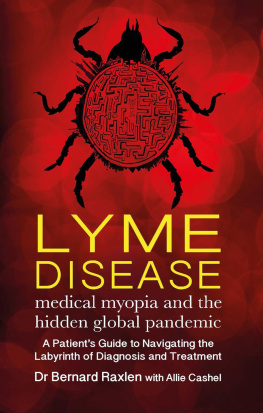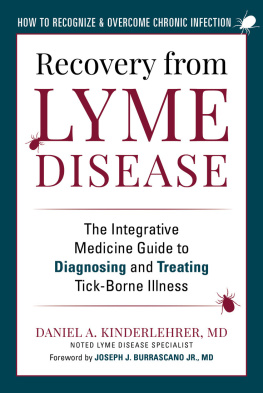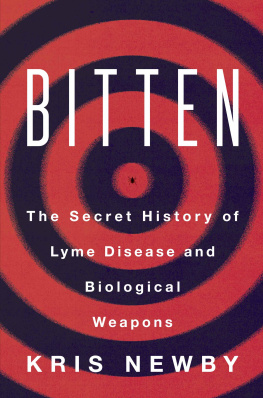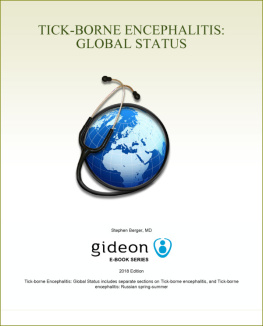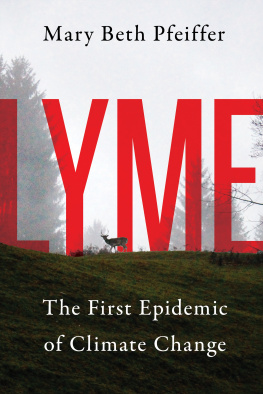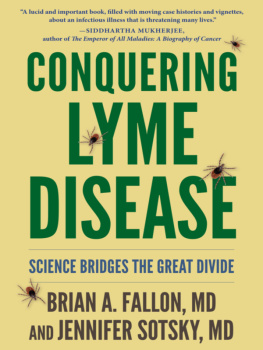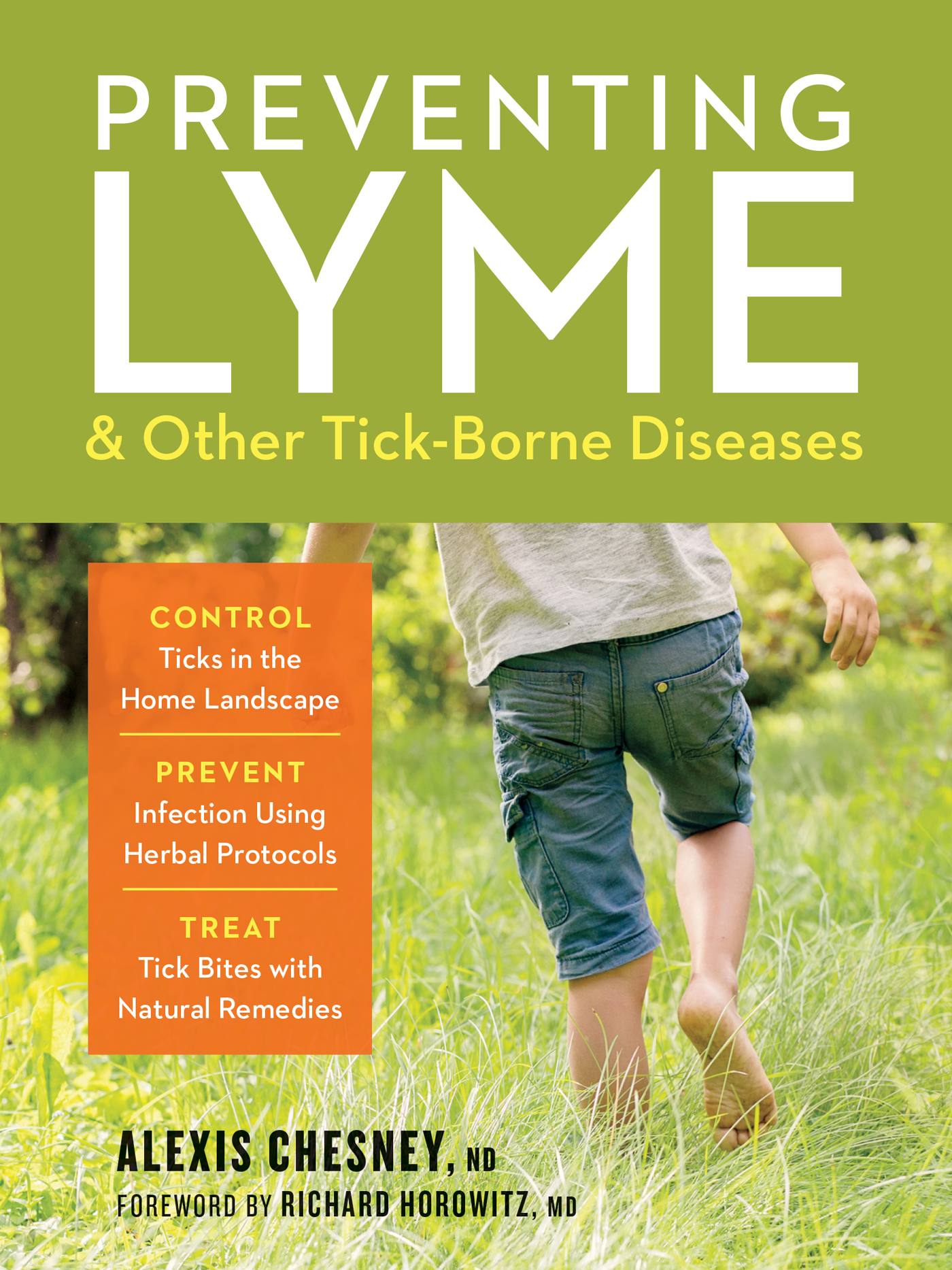The mission of Storey Publishing is to serve our customers by publishing practical information that encourages personal independence in harmony with the environment.
Edited by Carleen Madigan, Nancy Ringer, and Sarah Guare
Cover design by Michaela Jebb
Book design by Michaela Jebb and Erin Dawson
Indexed by Christine R. Lindemer, Boston Road Communications
Cover photography by mrs/Getty Images
Lyme rash ID photography by anakopa/iStock.com, 1 t.l.; Originally printed as reference for Diagnostic challenges of early Lyme disease: Lessons from a community case series, by John Aucott et al. BMC Infectious Diseases 9, 79 (2009). www.researchgate.net/publication/26257313 . Licensed via the CC BY 2.0., 2 b.r.; dennisjacobsen/stock.adobe.com, 1 b.r.; imageBROKER/Alamy Stock Photo, 1 t.r.; JerryCallaghan/iStock.com, 1 b.l.; Jaroslav Moravcik/stock.adobe .com, 2 t.r.; Mikael Hggstrm/Wikimedia Commons, 2 t.l.; Originally printed as reference for Bullous Lyme disease by Jeffrey B. Tiger, Marshall A. Guill III, and M. Shane Champman. Journal of the American Academy of Dermatology 71, no. 4 (2014). www.sciencedirect.com/science/article/pii/S0190962214013917 . Licensed via the CC BY-NC-ND 4.0., 2 b.l.; Tramper2/stock.adobe.com, 1 m.r.
Illustrations by Beverly Duncan, except by Ilona Sherratt
Range maps by Ilona Sherratt
Life cycle diagram on )
Text 2020 by Alexis Chesney
Ebook production by Slavica A. Walzl
Ebook version 1.0
March 3, 2020
All rights reserved. No part of this book may be reproduced without written permission from the publisher, except by a reviewer who may quote brief passages or reproduce illustrations in a review with appropriate credits; nor may any part of this book be reproduced, stored in a retrieval system, or transmitted in any form or by any means electronic, mechanical, photocopying, recording, or other without written permission from the publisher.
The information in this book is true and complete to the best of our knowledge. All recommendations are made without guarantee on the part of the author or Storey Publishing. The author and publisher disclaim any liability in connection with the use of this information.
This publication is intended to provide educational information on the covered subject. It is not intended to take the place of personalized medical counseling, diagnosis, and treatment from a trained health professional.
Storey books are available at special discounts when purchased in bulk for premiums, promotions, fund-raising, or educational use. Special editions or book excerpts can be created to specification. For details, please call 800-827-8673, or email .
Storey Publishing
210 MASS MoCA Way
North Adams, MA 01247
storey.com
Library of Congress Cataloging-in-Publication Data on file
To all of my patients
Thank you for the honor of inviting me to walk with you on your healing journeys.
And to my grandmother Nani
Thank you for your love and inspiration. I would not be where I am today had it not been for you.
Contents
Foreword
Why Its Important to Protect Yourself from Tick-Borne Diseases
Over the last several decades, tick-borne diseases (TBD) have been slowly spreading across the United States and the rest of the world, adversely affecting the lives of millions of people. In this country, all 50 states have reported cases of Lyme disease, and the numbers keep increasing. During the last 20 years, there has been a 320 percent increase in U.S. counties reporting ticks containing Lyme disease, as well as an alarming threefold increase in vector-borne disease cases overall. Confirming these public health reports, Quest Laboratories recently reported close to a doubling of positive Lyme testing among those being screened in 2018. These rising numbers do not account for those never screened, those who are tested but whose results show a false negative for Lyme (due to the insensitivity of the testing), or those who are never screened for associated co-infections present in the ticks.
Co-infection of ticks is now the rule, not the exception, and up to 85 percent of those with Lyme disease have been exposed to other pathogens in ticks. And transmission can happen rapidly: Powassan virus can be transmitted within 15 minutes of a tick bite, rickettsial infections can be transmitted within 10 minutes, and the relapsing fever borrelia, Borrelia hermsii, can be transmitted within just 5 minutes.
The symptoms of many of these co-infections can mimic those of Lyme. Even with early antibiotic treatment, they can have long-term disabling effects, adversely affecting the quality of your life and impairing your ability to work and be a productive member of society. Co-infections are potentially fatal in the young and elderly, especially in those with impaired immune system functioning.
Tick-borne infections can also mimic other chronic debilitating conditions, including chronic fatigue syndrome/myalgic encephalomyelitis, fibromyalgia, autoimmune diseases like rheumatoid arthritis or multiple sclerosis, and even autism or Alzheimers disease. Tick-borne infections combined with environmental toxins have been reported in the medical literature to potentially play a role in all of these diseases. In fact, after seeing more than 13,000 chronically ill individuals with Lyme and TBD during the past 30 years, I am convinced that tick-borne infections are at the root of many unexplained symptoms and illnesses. In searching for answers for my sick and suffering patients, I have found up to 16 reasons why people may remain ill. I call this MSIDS multiple infectious disease syndrome and this model accounts for how tick-borne infections, along with overlapping sources of inflammation and their downstream effects, can lead to chronic illness.
Proper prevention is crucial, and the measures Dr. Chesney outlines in this book will certainly help save lives and prevent unnecessary suffering. There is no reason to tempt fate. Every time you go outside, use the tick-prevention measures discussed in this book. A small tick can cause long-lasting health issues that keep you from living life to the fullest. You will be well served to be mindful of this spreading epidemic, follow Dr. Chesneys advice, and protect yourself and your loved ones accordingly.
Richard Horowitz, MD,New York Times bestselling author of Why Cant I Get Better? and How Can I Get Better?
Preface
My grandmother had rheumatic fever as a child and, as a result, she suffered from heart-related complications her whole life. Growing up, I spent a lot of time visiting her at the hospital. This was the same hospital where my aunt worked, where I later volunteered, and where I returned to work as a nurse extender the year after I graduated from college. This meant that I worked on a medical-surgical floor supporting the nurses as I drew blood, took vital signs, and monitored the telemetry, as well as providing comfort care to patients. At the same time, I was preparing for the MCAT (Medical College Admission Test).
I really loved the hospital but felt there was something missing. I found myself constantly thinking about what had happened to all these patients before they became so ill. What had led them to need heart surgery and chronic medications? I started reading Dr. Andrew Weils books and learning more about natural therapies. The idea that the body had an inherent capacity to heal itself resonated strongly with me. Preventing heart disease the leading cause of death in the United States through diet, exercise, and lifestyle changes made sense to me. This shift in perspective led me to enter school to begin training as a naturopathic doctor in Bridgeport, Connecticut, instead of becoming a conventional allopathic doctor.


